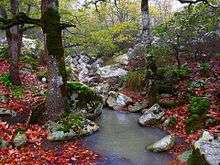Jendouba
| Jendouba جندوبة | |
|---|---|
 Jendouba | |
| Coordinates: 36°29′N 08°47′E / 36.483°N 8.783°E | |
| Country | Tunisia |
| Governorates | Jendouba Governorate |
| Government | |
| • Ayoub Hajji | Ayoub Hajji |
| Elevation | 143 m (469 ft) |
| Population (2014) | |
| • Total | 113,116 |
| Time zone | CET (UTC+1) |
| • Summer (DST) | CEST (UTC+2) |
| Website | www.commune-jendouba.gov.tn |
Jendouba (Tunisian Arabic: جندوبة ![]() Jāndūba ; from Amazigh Jen: Market, Douba: Wheat) Formerly known as Souk El Arba until 30 April 1966) is a large city in north-western Tunisia, and capital of the Jendouba Governorate. It is an important crossroads with many road links to other towns such as El Kef, Tabarka, Ain Draham and Béja. The main economic activity is agriculture. It is close to the famous ancient Roman city of Bullaregia or Bulla Regia, as well as the ancient marble quarry of Chemtou.
Jāndūba ; from Amazigh Jen: Market, Douba: Wheat) Formerly known as Souk El Arba until 30 April 1966) is a large city in north-western Tunisia, and capital of the Jendouba Governorate. It is an important crossroads with many road links to other towns such as El Kef, Tabarka, Ain Draham and Béja. The main economic activity is agriculture. It is close to the famous ancient Roman city of Bullaregia or Bulla Regia, as well as the ancient marble quarry of Chemtou.
History
Historically, this region was important and wealthy. The historical importance comes clear with the nearby great Roman cities of Bulla Regia and Chemtou.
Several historical sites still witness the role this city played centuries ago to improve the economy in the region.
Jendouba is remembered to be the Tunisian area to start the April 9th, 1934 civil claim for independence from French colonization.
The protestations started in the town of Oued Meliz on April 4, 1934 before arriving in the capital and becoming a national movement.
.jpg)
The "events of April 9, 1938 " ( 9 أحداث أفريل 1938) were street protests demanding political reforms, including the establishment of a parliament, a major step towards the independence of Tunisia whilst a French protectorate. They resulted in a bloody shootout that marked the start of the Tunisian national movement.
Economy
Coordinates: 36°30′N 8°47′E / 36.500°N 8.783°E

